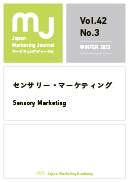Volume 42, Issue 3
Sensory Marketing
Displaying 1-14 of 14 articles from this issue
- |<
- <
- 1
- >
- >|
Preface
-
2023 Volume 42 Issue 3 Pages 3-5
Published: January 10, 2023
Released on J-STAGE: January 10, 2023
Download PDF (325K) Full view HTML
Special Issue / Invited Peer-Reviewed Article
-
2023 Volume 42 Issue 3 Pages 6-16
Published: January 10, 2023
Released on J-STAGE: January 10, 2023
Download PDF (546K) Full view HTML -
2023 Volume 42 Issue 3 Pages 17-26
Published: January 10, 2023
Released on J-STAGE: January 10, 2023
Download PDF (1689K) Full view HTML -
2023 Volume 42 Issue 3 Pages 27-38
Published: January 10, 2023
Released on J-STAGE: January 10, 2023
Download PDF (744K) Full view HTML -
2023 Volume 42 Issue 3 Pages 39-50
Published: January 10, 2023
Released on J-STAGE: January 10, 2023
Download PDF (743K) Full view HTML -
2023 Volume 42 Issue 3 Pages 51-62
Published: January 10, 2023
Released on J-STAGE: January 10, 2023
Download PDF (819K) Full view HTML
Review Article / Invited Peer-Reviewed Article
-
2023 Volume 42 Issue 3 Pages 63-71
Published: January 10, 2023
Released on J-STAGE: January 10, 2023
Download PDF (451K) Full view HTML -
2023 Volume 42 Issue 3 Pages 72-80
Published: January 10, 2023
Released on J-STAGE: January 10, 2023
Download PDF (534K) Full view HTML
Marketing Case
-
2023 Volume 42 Issue 3 Pages 81-87
Published: January 10, 2023
Released on J-STAGE: January 10, 2023
Download PDF (784K) Full view HTML
Book Review
-
2023 Volume 42 Issue 3 Pages 88-89
Published: January 10, 2023
Released on J-STAGE: January 10, 2023
Download PDF (278K) Full view HTML -
2023 Volume 42 Issue 3 Pages 90-92
Published: January 10, 2023
Released on J-STAGE: January 10, 2023
Download PDF (332K) Full view HTML -
2023 Volume 42 Issue 3 Pages 93-95
Published: January 10, 2023
Released on J-STAGE: January 10, 2023
Download PDF (331K) Full view HTML
Errata
-
2023 Volume 42 Issue 3 Pages 96
Published: January 10, 2023
Released on J-STAGE: January 10, 2023
Download PDF (502K)
Editorial Note
-
2023 Volume 42 Issue 3 Pages 97
Published: January 10, 2023
Released on J-STAGE: January 10, 2023
Download PDF (638K) Full view HTML
- |<
- <
- 1
- >
- >|
